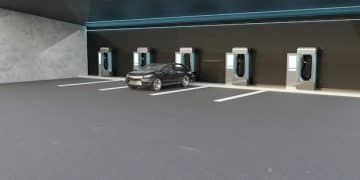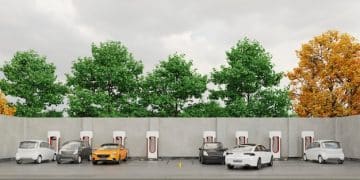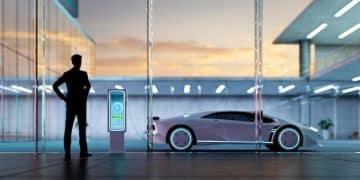Impact of 18% EV Sales Increase on US Auto Dealerships by 2025
The projected 18% increase in electric vehicle (EV) sales by 2025 will significantly impact US auto dealerships, requiring them to adapt their business models, invest in charging infrastructure and specialized training, and navigate evolving consumer preferences to remain competitive.
The automotive industry is on the cusp of a major transformation, driven by the increasing adoption of electric vehicles (EVs). A projected 18% increase in EV sales by 2025 promises exciting opportunities, but it also presents significant challenges to US auto dealerships. How will dealerships adapt?
Navigating the Electric Vehicle Revolution: Challenges and Opportunities for US Auto Dealerships
The rise of electric vehicles is no longer a distant future scenario; it’s happening now. As EV sales continue to climb, US auto dealerships find themselves at a crossroads, needing to adapt to stay afloat in this rapidly evolving market. This shift isn’t just about selling different cars; it’s about transforming the entire dealership experience.
Here, we’ll delve into the complexities this projected growth presents and how dealerships can strategically position themselves for success.
Adapting the Sales Process for Electric Vehicles
The sales process for EVs differs significantly from that of traditional gasoline-powered cars. Dealerships need to train their sales staff to effectively communicate the benefits of EVs.
- Highlighting Long-Term Savings: EVs offer lower running costs due to reduced fuel expenses and maintenance needs.
- Explaining Government Incentives: Educating customers on available tax credits and rebates can sweeten the deal.
- Showcasing Performance: EVs provide instant torque and a smooth driving experience, factors that many customers find appealing.
Investing in Service and Maintenance Infrastructure
EVs require specialized maintenance and repair skills compared to traditional vehicles. Dealerships must invest in training their technicians and acquiring the necessary diagnostic tools.
Furthermore, building EV expertise within their service departments is a strategic step. By upskilling technicians and investing in specialized tools, dealerships can effectively cater to the unique maintenance needs of EVs. This ensures customer satisfaction and cultivates long-term relationships with EV owners.
Dealerships that proactively address the service and maintenance aspects of EVs will be better positioned to thrive in the evolving automotive landscape.
In conclusion, adapting the sales process to showcase long-term savings and investing in service and maintenance infrastructure are crucial for US auto dealerships to succeed in the EV market.
The Charging Predicament: Infrastructure and Customer Expectations
One of the biggest hurdles dealerships face is the lack of widespread EV charging infrastructure. Customers need to be confident that they can easily charge their vehicles at home and on the road.
Dealerships have a role to play in addressing these concerns. Here’s how:
Installing On-Site Charging Stations
Providing charging stations at the dealership demonstrates a commitment to EVs and allows customers to experience charging firsthand.
Partnering with Charging Network Providers
Collaborating with companies like Tesla, ChargePoint, or EVgo can provide access to a larger network of chargers and offer bundled charging packages to customers.
Educating Customers on Home Charging Options
Guiding customers through the process of installing home chargers and understanding different charging levels can alleviate range anxiety.
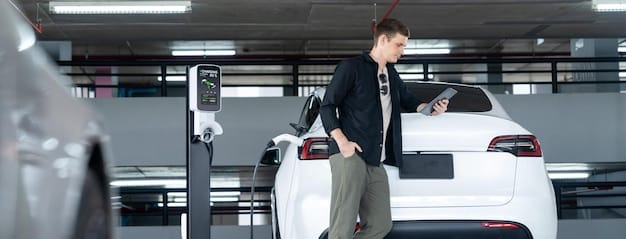
These strategies not only enhance customer convenience but also position dealerships as trusted advisors in the transition to electric mobility.
Moreover, dealerships can establish partnerships with local businesses to create charging hubs. This collaborative approach not only expands charging accessibility but also fosters community engagement and creates new revenue streams.
In summary, addressing the charging predicament through infrastructure investments and customer education is paramount for dealerships aiming to capitalize on the EV revolution, fostering trust and driving sales.
Evolving Dealership Business Models for an Electric Future
The traditional dealership model, heavily reliant on service and parts revenue from gasoline-powered cars, needs to adapt to the world of EVs, which have fewer moving parts and require less maintenance.
Here’s how dealerships are exploring new revenue streams:
Focusing on Software and Subscription Services
EVs are becoming increasingly software-defined, creating opportunities for dealerships to offer subscription-based services like over-the-air updates, advanced driver-assistance systems (ADAS), and entertainment packages.
Expanding into Battery Services
As EV batteries age, dealerships can offer battery diagnostics, repair, and replacement services, ensuring the longevity and performance of the vehicles they sell.
Creating a “Mobility Hub” Concept
Some dealerships are transforming into mobility hubs, offering a range of transportation solutions, including EV rentals, car-sharing programs, and micro-mobility options like electric scooters and bikes.
These revenue-generating avenues, coupled with enhanced customer satisfaction from reliable EV service, will ensure dealership stability in the changing automotive market.
Moreover, by diversifying services, dealerships can attract new customer segments and foster stronger relationships with their existing clientele. This forward-thinking approach not only secures financial stability but also positions dealerships as leaders in the evolving transportation landscape.
Therefore, evolving dealership business models by focusing on software and subscription services, and expanding into battery services is critical for long-term viability in the EV era.
The Impact on Dealership Floorplans and Inventory Management
The arrival of EVs necessitates a rethinking of dealership layout and inventory management. EVs typically require more space for displays and charging infrastructure.
Effective strategies that dealerships can implement include:
Allocating More Space to EV Displays
Showcasing a variety of EV models and charging solutions can attract customers and highlight the dealership’s commitment to electrification.
Optimizing Inventory Levels
Balancing the demand for EVs with the availability of gasoline-powered cars requires careful planning and forecasting.
Implementing “Just-In-Time” Inventory Management
This approach minimizes the need for large on-site inventories, reducing carrying costs and allowing dealerships to focus on customer orders.
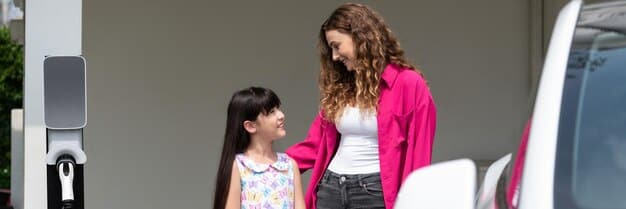
By optimizing floorplans and inventory management, dealerships can enhance the customer experience and streamline operations.
Furthermore, adopting digital inventory management tools is essential. These technologies provide real-time data on market trends and customer preferences, allowing dealerships to make informed decisions about inventory levels. This data-driven approach minimizes the risk of overstocking or understocking, optimizing profitability and ensuring customer satisfaction.
In short, strategic floorplan design and inventory optimization are vital for dealerships to efficiently manage the transition to EVs, maximizing space utilization and responding effectively to changing customer demands.
Training and Upskilling the Dealership Workforce
From sales staff to service technicians, every member of the dealership workforce needs to be trained on the intricacies of EVs. This includes understanding the technology, sales strategies, and maintenance procedures specific to electric vehicles.
Key components of successful workforce development include:
Comprehensive EV Training Programs
Providing hands-on training and certifications for technicians and sales staff can build confidence and expertise. Ensuring that the team is well-versed in EV technology will enable them to communicate effectively and address customer queries.
Incentivizing Employee Development
Offering bonuses or promotions for completing EV-related training can encourage employees to embrace the transition. When employees see a clear benefit to developing new skills, they are more likely to invest their time and energy in learning.
Creating a Culture of Continuous Learning
The EV landscape is constantly evolving, so dealerships need to foster a culture of continuous learning to keep their workforce up-to-date.
Regular workshops, online courses, and industry conferences can help employees stay informed about the latest developments. This ensures that the workforce is always prepared to meet the changing demands of the EV market.
In conclusion, investing in employee development is vital. Properly trained staff provide outstanding customer service and can smoothly introduce the transition from traditional car sales to future electric car sales.
Government Policies and Incentives: A Shifting Landscape
Government policies and incentives play a crucial role in driving EV adoption. Dealerships need to stay informed about these policies and how they impact their business and their customers.
Essential aspects to consider include:
Understanding Federal and State Tax Credits
Educating customers on available tax credits and rebates can be a powerful sales tool. When governments offer financial incentives, more customers are willing and able to invest in EVs. Dealerships that actively promote these incentives can close more deals.
Staying Informed About Emission Regulations
Changes in emission standards can impact the types of vehicles that dealerships can sell. Keeping up-to-date with these regulations ensures that dealerships remain compliant and competitive.
Advocating for Favorable Policies
Dealerships can work with industry associations to advocate for policies that support EV adoption. By participating in policy discussions, dealerships can help shape the future of the automotive industry.
Advocating also involves promoting sustainable practices within their own operations. This shows leadership and enhances their reputation.
In summary, staying informed about government policies helps to drive EV adoption. In addition, advocating for favorable policies and understanding tax credits is important.
| Key Point | Brief Description |
|---|---|
| ⚡EV Sales Impact | Dealerships must adapt to changing consumer demand and preferences. |
| 🔌Charging Infrastructure | Investment in charging stations is crucial for attracting EV buyers. |
| 🛠️Workforce Training | Technicians need specialized training for servicing electric vehicles. |
| 💰 New Revenue Streams | Service subscriptions and battery maintenance offers new opportunities. |
What are the main challenges US auto dealerships face with the rise in EV sales?
▼
Dealerships will need to adapt from relying on traditional car service to exploring new revenue streams, such as software subscriptions and battery maintenance, given EVs require less frequent maintenance.
▼
Providing on-site charging stations attracts EV buyers and eases customer concerns about charging availability. Also, dealerships can partner with charging networks to provide more resources.
▼
All staff, from salespeople to technicians, will need comprehensive training to handle EVs effectively. Technicians require certification for EV repairs, while sales staff must understand all the vehicle aspects.
▼
Dealerships must balance inventory between EVs and gasoline cars and utilize “just-in-time” inventory management to reduce costs. This can assist with streamlining the inventory to match consumer demand.
▼
Government incentives significantly boost EV adoption, so dealerships need to educate customers on available tax credits. Staying informed about changing emission regulations also helps dealerships stay informed.
Conclusion
The projected 18% increase in electric vehicle sales by 2025 marks a pivotal moment for US auto dealerships. To thrive amidst this transformative shift, dealerships must proactively adapt, embrace innovation, and prioritize customer needs. By investing in charging infrastructure, upskilling their workforce, and exploring new business models, dealerships can seize the opportunities presented by the EV revolution and secure a sustainable future in the automotive industry.
